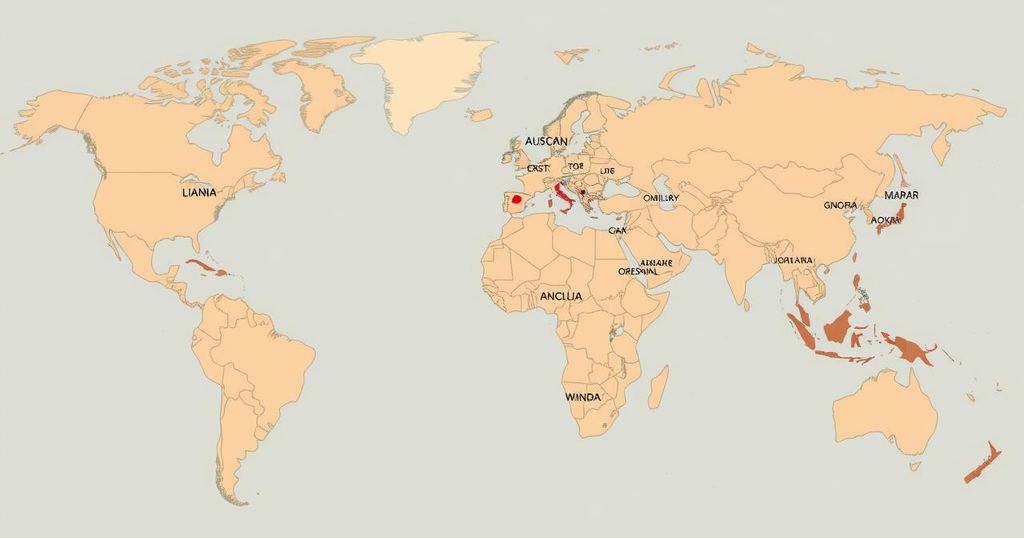The U.S. Department of State has escalated travel warnings for numerous countries, advising against travel due to increased risks associated with crime, political instability, and violence. Popular destinations like Afghanistan, the Congo, and Ukraine are under Level 4 advisories, marking them as extremely unsafe for American travelers. The shifting advisory landscape calls for heightened awareness among tourists as spring break approaches.
The U.S. Department of State has significantly tightened travel advisories for several destinations in advance of the spring break season. Countries including Russia, Jamaica, Colombia, Belarus, Yemen, Syria, the Dominican Republic, Congo, Afghanistan, Mexico, Burundi, the Bahamas, Lebanon, the Central African Republic, Iraq, Ukraine, Venezuela, Haiti, Iran, Myanmar, South Sudan, Mali, Burkina Faso, and North Korea now receive advisories ranging from Level 3 (Reconsider Travel) to Level 4 (Do Not Travel). This shift highlights rising concerns about crime, political instability, and terrorist activities in these regions.
American tourists have historically flocked to these destinations for their cultural allure and scenic locales. However, the recent warnings underscore a deteriorating security landscape that jeopardizes both the local populace and international visitors. The advisories reflect a surge in violent crime, including kidnappings and aggravated robberies, prompting the U.S. government to issue new safety guidelines for its citizens.
Countries placed under a Level 4 advisory are identified as especially hazardous due to extreme conditions such as ongoing conflicts or governmental instability. This most serious travel warning indicates that the risks to travelers are critically elevated, especially in nations like Afghanistan, the Congo, and Lebanon, where conditions continue to worsen.
As of February 2025, countries such as Afghanistan have been identified as perilous for travelers due to the resurgence of the Taliban and ongoing violence. Similarly, the Democratic Republic of the Congo grapples with armed militia activity and insufficient governance, creating a dangerous environment. Lebanon experiences political discord that fuels unrest and risks to visitor safety, alongside issues in the Central African Republic where violence and violence abduction are rampant.
Belarus is marked by political oppression and instability, posing risks of harassment for U.S. citizens. In Iraq, the threats from ISIS and other militant factions continue to render the country unsafe for travel. Current conditions in Ukraine, exacerbated by military conflict, mandate strong advisories against American visitation.
Venezuela’s political and economic crises have led to hyperinflation and civil unrest, while Haiti suffers from significant gang violence that poses direct threats to visitors. Iran remains a contentious destination due to political unrest and the risk of detention for foreign guests. The U.S. government warns against travel to these countries, urging citizens to evaluate their safety seriously.
It is imperative for travelers considering visiting high-risk nations to adhere to safety measures, such as checking the U.S. State Department’s travel advisory page, enrolling in the Smart Traveler Enrollment Program (STEP), and maintaining communication with local embassies. Travelers are also advised to purchase robust travel insurance and remain cognizant of their surroundings.
The impact of these travel advisories is crucial for the tourism industry, affecting airlines, tour operators, and travel agencies. As safety concerns grow, these entities may need to adapt their offerings and increase awareness among potential travelers about current conditions. The advisory system evaluates risks based on crime rates, civil unrest, and emergency service availability, which directly influences traveler safety perceptions.
Further, despite the travel warnings, many travelers may choose to visit these advised countries, often underestimating the dangers. As the spring break period approaches, awareness of these travel advisories becomes essential for ensuring safe travel experiences in potentially hazardous locations.
The issuance of Level 3 and Level 4 travel advisories underscores significant risks faced by U.S. travelers in various regions, particularly those in Latin America and the Caribbean. As the spring break season draws near, it is crucial for citizens to remain vigilant about their safety and reconsider any travel plans to the highlighted destinations. The travel industry must also adapt accordingly, emphasizing the importance of informed decision-making and awareness of the evolving global landscape.
Original Source: www.travelandtourworld.com




